
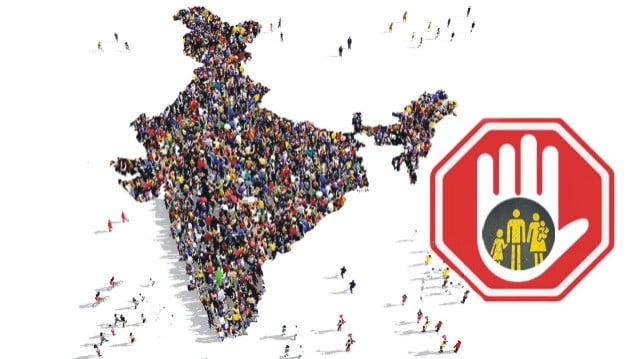
Demographic balance is essential as imbalance leads to conflicts and drives a socio-economic instability. Socio-economic balance gives stability and retains harmony and cultural diversity.
While this is true, for long, we hear that India’s demographic balance is changing, and we also hear fear-mongering by right-wing elements about what they perceive is not stable. At times one community is blamed for such imbalance.
There is a recent debate over a population control bill. The question is – does India needs a population control bill? The answer lies in facts and not fiction.
India’s population growth is declining. The fertility rate shows a decline over the years. Currently, it is slightly over 2, but if this continues, the population will start dropping in next few years.
Fig 1: Declining Fertility rate in India
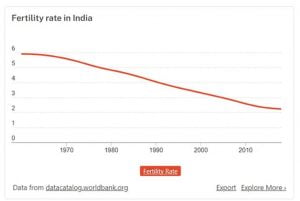 Source: datacommons.org
Source: datacommons.org
Fig 2: Declining Population growth India.
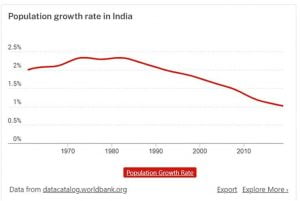
Source: datacommons.org
There is often a perception that a particular community is growing faster than other communities. The Hindus and Muslims are the major communities in India. The fertility rates have been converging.
Fig 3: Changing fertlity rates of Hindus and Muslims
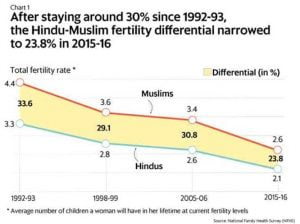 Source: Mint
Source: Mint
This gap has further narrowed down, but comparatively, Muslims have a higher fertility rate. There is no religious basis to it, though. Let us look at the states with a good Muslim (>20%) population and see the fertility rates.
For all of them, the total fertility rate is less than the national average of 2.2. Most of these states will see decreasing population trends. The states dominated by Muslim population sees one of the lowest fertility rates.
Table 1: The Fertility Rates of states with sizeable Muslim population
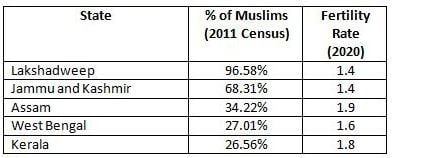
Source: Muslim Population: Census 2011 Fertility Rates: Wikipedia
Bihar, which has only 16.87% of Muslims, has registered a Fertility rate of 3.0 during 2020, and Meghalaya, which has a Muslim population of only 4.4% with a fertility rate of 2.9 during 2020. Hence, Hence it won’t be easy to connect fertility rates to one community.
The motives behind bringing such a population bill do not make sense as the population of India is declining in many states. If the fertility rates fall below two, both parents cannot replace themselves, and there is a gap.
Some thought leaders often appreciate China adopted the one-child policy. But, if it was so successful, why did they adopt a three-child policy to fill the massive gap? Moreover, experts often ask whether China can ever recover from its disastrous one-child policy.
The issues are not different in Japan, Italy, and many more countries where the population is declining at an alarming rate. Japan today has a huge older population, and so does Italy, where the percentage of older adults is very significant. Over a period, Nations like them will see much immigration, a decline in the economy, or even face an existential threat.
On the other hand, India was facing a challenge because of its huge population. Gradually, the same population became its strength when the shift started happening from agriculture-based economy to services-based economy. A considerable workforce and cheap labor changed the economy and GDP. The sector contribution of India is shown below: –
Fig 4: Sectoral distribution
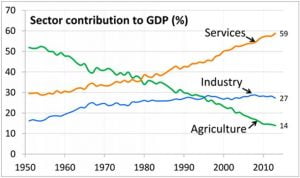
Source: Wikipedia
The vast population provides access to the workforce in a service-driven economy. In addition, the income growth per capita creates better and more significant opportunities to fuel further growth. Therefore, India can address the skill gap much better than others converting the threat of a large population into an opportunity.
To conclude, India does not need a population control bill; instead, it should explore how to leverage the current workforce and provide better skill development capabilities. Therefore, the population Control bill, unless meant to serve some other intent, may be counterproductive. ![]()
Also Read:
South Africa and India – Both Descending into Chaos and Anarchy
Watch video:

Disclaimer : PunjabTodayTV.com and other platforms of the Punjab Today group strive to include views and opinions from across the entire spectrum, but by no means do we agree with everything we publish. Our efforts and editorial choices consistently underscore our authors’ right to the freedom of speech. However, it should be clear to all readers that individual authors are responsible for the information, ideas or opinions in their articles, and very often, these do not reflect the views of PunjabTodayTV.com or other platforms of the group. Punjab Today does not assume any responsibility or liability for the views of authors whose work appears here.
Punjab Today believes in serious, engaging, narrative journalism at a time when mainstream media houses seem to have given up on long-form writing and news television has blurred or altogether erased the lines between news and slapstick entertainment. We at Punjab Today believe that readers such as yourself appreciate cerebral journalism, and would like you to hold us against the best international industry standards. Brickbats are welcome even more than bouquets, though an occasional pat on the back is always encouraging. Good journalism can be a lifeline in these uncertain times worldwide. You can support us in myriad ways. To begin with, by spreading word about us and forwarding this reportage. Stay engaged.
— Team PT


Copyright © Punjab Today TV : All right Reserve 2016 - 2025 |